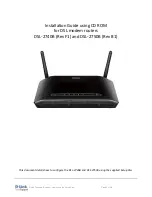
89
Port number
A number that identifies a TCP/IP-based service. Telnet, for example, is identified with TCP port
23.
Protocol
A set of rules for communication, sometimes made up of several smaller sets of rules also called
protocols.
PPP
Point-to-Point Protocol - A Data Link layer protocol that provides asynchronous and synchronous
connectivity between computer/network nodes. It defines how packets of information are
exchanged between computers or network nodes connect via a point-to-point connection (as
opposed to multipoint or broadcast). Includes standardization for security and compression
negotiation.
PVC
Permanent Virtual Circuit - Dedicated connection between end stations. The PVC is made up of 2
parts: the VPI and the VCI. In a PVC number of 0,32, 0 represents the Virtual Path Identifier (VPI)
and 32 represents the Virtual Circuit Identifier (VCI).
RFC 1483
Protocol that encapsulates ATM cells into logical data link frames.
RFC
Request for Comment - A series of documents used to exchange information and standards about
the Internet.
RIP
Routing Information Protocol -
A protocol used for the transmission of IP routing information.
RJ-11
A telephone-industry standard connector type, usually containing four pins.
RJ-45
A telephone-industry standard connector type, usually containing eight pins.
Routing
A network layer function that determines the path for transmitting packets through a network
from source to destination.
Router
A device that supports network communications. A router can connect identical network types,
However—unless a gateway is available—a common protocol, such as TCP/IP, must be used over
both networks. Routers may be equipped to provide WAN line support to the LAN devices they
serve. They may also provide various management and monitoring functions as well as a variety of
configuration capabilities.
Routing table
A list of networks maintained by each router on an internet. Information in the routing table helps
the router determine the next router to forward packets to.
Serial port
A connector on the back of the workstation through which data flows to and from a serial device.
Server
A device or system that has been specifically configured to provide a service, usually to a group of
clients.
Subnet
A network address created by using a subnet mask to specify that a number of bits in an internet
address will be used as a subnet number rather than a host address.
Subnet Address
An extension of the Internet 32-bit addressing scheme which allows the separation of physical or
logical networks within the single network number. assigned to an organization. TCP/IP entities
outside this organization have no knowledge of the internal ‘subnetting’.
Subnet mask
A 32-bit number to specify which part of an internet address is the network number, and which
part is the host address. When written in binary notation, each bit written as 1 corresponds to 1 bit
of network address information. One subnet mask applies to all IP devices on an individual IP
network.
RS-232
EIA standard specifying the physical layer interface used to connect a device to communications
media.




































